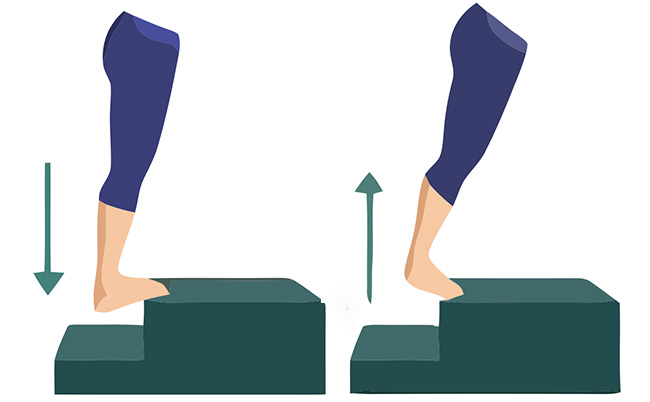Plantar fasciitis is a common foot problem, often felt as heel pain or discomfort in the sole of the foot. It’s usually worse when you first get up in the morning or after sitting for a while. Although it can affect anyone, it’s more common in people who don’t move around a lot, but even runners can get it.
There are many ways to treat plantar fasciitis. You might have heard about foam rolling, special shoe inserts, or losing weight to ease the pain. Strength training is often a recommended treatment, although a recent research review suggested that doing strength exercises alone might not be the best solution, and instead, recommended a combination of strengthening, stretching, taping the foot, and learning more about the condition as the main treatments. (1)
Below we will outline 5 methods to manage plantar fasciitis, focusing on the research around each topic.
Strength Training
On social media, you might see people saying that making your foot muscles stronger can fix plantar fasciitis. The idea is to help your foot handle more stress without pain. However, a study showed that after 12 weeks of a strength training program, there wasn’t a big difference in pain relief. This doesn’t mean strength exercises are useless, but they might not be necessary for everyone. They can still be part of the treatment, especially if you enjoy them or need to get back to sports. (2)
Stretching
Stretching the calf muscles is a common suggestion for plantar fasciitis. A study found that doing specific stretches really helped with tight calf muscles and reduced pain. However, it’s not just about stretching; the exercise program also made the muscles stronger. So, while stretching is helpful, it should be tailored to each person’s needs. (3)
Orthoses/Insoles 
There’s some debate about whether special shoe inserts help with plantar fasciitis. In one study, people who just received usual care from their doctor improved more than those who got custom-made shoe inserts. This doesn’t mean inserts are always a bad idea, but they might not be the first thing to try. They could be added to the treatment plan later if needed. (4)
Footwear
Changing your shoes might help with plantar fasciitis symptoms. A study compared extra-cushioned shoes to regular running shoes and found that the cushioned ones helped reduce pain more. However, it’s still unclear what the best type of shoe is for this condition. (5)
Injections
Injections for plantar fasciitis are common, but they come with risks, like the possibility of the plantar fascia rupturing. A study compared injections, strength training, and a combination of both, finding that a mix of injections and exercises provided the most relief. However, injections should probably be considered only if other treatments haven’t worked.(6)
In summary, treating plantar fasciitis involves a mix of stretching, maybe some strength exercises, considering shoe inserts, looking at your footwear, and possibly injections if needed. It’s all about finding what works best for you.
If you suffer from foot pain or Plantar fasciitis – contact us for a FREE DISCOVERY EXAM to see if Physical Therapy can help!
References:
- Morrissey D, Cotchett M, Said J’Bari A, Prior T, Griffiths IB, Rathleff MS, Gulle H, Vicenzino B, Barton CJ. Management of plantar heel pain: a best practice guide informed by a systematic review, expert clinical reasoning and patient values. Br J Sports Med. 2021 Oct;55(19):1106-1118. doi: 10.1136/bjsports-2019-101970. Epub 2021 Mar 30. PMID: 33785535; PMCID: PMC8458083.
- Riel, H., Jensen, M. B., Olesen, J. L., Vicenzino, B., & Rathleff, M. S. (2019). Self-dosed and pre-determined progressive heavy-slow resistance training have similar effects in people with plantar fasciopathy: a randomised trial. Journal of physiotherapy, 65(3), 144-151.
- Pearce, C. J., Seow, D., & Lau, B. P. (2021). Correlation between gastrocnemius tightness and heel pain severity in plantar fasciitis. Foot & Ankle International, 42(1), 76-82.
- Rasenberg, N., Bierma-Zeinstra, S. M., Fuit, L., Rathleff, M. S., Dieker, A., Van Veldhoven, P., … & Van Middelkoop, M. (2021). Custom insoles versus sham and GP-led usual care in patients with plantar heel pain: results of the STAP-study-a randomised controlled trial. British journal of sports medicine, 55(5), 272-278.
- Fridman R, Obradovic, K (2022) A Prospective study on maximialist athletic shoes as part of comprehensive approach to th medical management of early-stage plantar fasciitis. Clinical Research on Foot & Ankle, 10(1), 329.
- Johannsen, F. E., Herzog, R. B., Malmgaard-Clausen, N. M., Hoegberget-Kalisz, M., Magnusson, S. P., & Kjaer, M. (2019). Corticosteroid injection is the best treatment in plantar fasciitis if combined with controlled training. Knee Surgery, Sports Traumatology, Arthroscopy, 27, 5-12.


